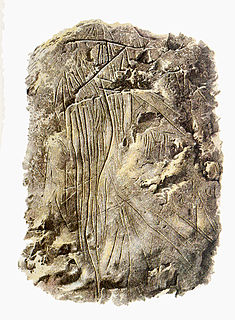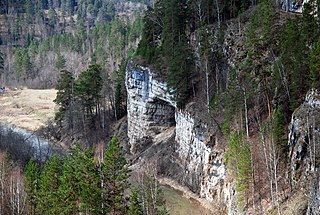 W
WCave paintings are a type of parietal art, found on the wall or ceilings of caves. The term usually implies prehistoric origin, and the oldest known are more than 44,000 years old, found in both the Franco-Cantabrian region in western Europe, and in the caves in the district of Maros. The oldest are often constructed from hand stencils and simple geometric shapes. However, more recently, in 2021, cave art of a pig found in an Indonesian island, and dated to over 45,500 years, has been reported.
 W
WBadanj Cave is located in Borojevići village near the town of Stolac, Bosnia and Herzegovina. This rather small cave has come to public attention after the 1976 discovery of its cave engravings, that date to between 12,000 and 16,000 BC.
 W
WCathole Cave, Cat Hole Cave or Cathole Rock Cave, is a cave near Parc Cwm long cairn at Parc le Breos, on the Gower Peninsula, Wales. It is a steep limestone outcrop, about 200 yards (180 m) north of the cromlech along the Parc le Breos Cwm valley and near the top of the gorge, about 50 feet (15 m) from the valley floor. The cave is a deep triangular fissure penetrating the hillside and narrowing towards the top. It has two entrances, with a natural platform outside the larger of the two. It is about seven 1⁄2 miles (12 km) west south–west of Swansea, Wales, in what is now known as Coed y Parc Cwm at Parc le Breos, on the Gower Peninsula.
 W
WThe Cave of the Beasts is a huge natural rock shelter in the Western Desert of Egypt featuring Neolithic rock paintings, more than 7,000 years old, with about 5,000 figures.
 W
WThe Cave of Swimmers is a cave with ancient rock art in the mountainous Gilf Kebir plateau of the Libyan Desert section of the Sahara. It is located in the New Valley Governorate of southwest Egypt, near the border with Libya.
 W
WCreswell Crags is an enclosed limestone gorge on the border between Derbyshire and Nottinghamshire, England, near the villages of Creswell and Whitwell. The cliffs in the ravine contain several caves that were occupied during the last ice age, between around 43,000 and 10,000 years ago. Its caves contain the northernmost cave art in Europe. The evidence of occupation found in the rich series of sediments that accumulated over many thousands of years is regarded as internationally unique in demonstrating how prehistoric people managed to live at the extreme northernmost limits of their territory during the Late Pleistocene period.
 W
WCueva Lucero is a cave and archeological site in the Guayabal barrio of the Juana Díaz municipality, in Puerto Rico. The cave includes more than 100 petroglyphs and pictographs "making it one of the best examples of aboriginal rock art in the Antilles." It has been known to archeologists since at least the early 1900s. Most of its images are zoomorphic. The site is known to locals including rock-climbers and spelunkers and there is some modern graffiti.
 W
WThe Addaura cave is a complex of three natural grottoes located on the northeast side of Mount Pellegrino in Palermo, Sicily, southern Italy. The importance of the complex is due to the presence of cave-wall engravings dated to the late Epigravettian and the Mesolithic.
 W
WIgnatievka Cave is a large limestone cave on the banks of the Sim River, a tributary of the Belaya river in the southern Ural Mountains of Russia. In 1980 a parietal wall painting of a venus figure was discovered. The twenty-eight red dots between her legs are believed to represent the female menstrual cycle.
 W
WKapova cave is a limestone karst cave in the Burzyansky District of Bashkortostan, Russia, ca. 200 km (120 mi) south-east of Ufa, in the southern Ural mountains. Located on the Belaya River in the natural reserve Shulgan-Tash, the cave is best known for the 16,000 years old Upper Paleolithic rock paintings and drawings.
 W
WLubang Jeriji Saléh is a limestone cave complex in the Sangkulirang-Mangkalihat Karst located in the remote jungle of Bengalon district in East Kutai, East Kalimantan province on Borneo island, Indonesia. In a 2018 publication a team of researchers announced to have found the then-oldest known work of figurative art in the world among the cave paintings, at 40,000 years old. However, the same team has since found and dated an elaborate therianthrope rock art panel in the Leang Bulu’ Sipong 4 cave in Sulawesi's Maros-Pangkep karst to around 44,000 years old, older than the figurative art in Lubang Jeriji Saléh.
 W
WThe prehistoric wall paintings of Magura have great resemblance with those of the Grotta dei Cervi in Italy, which are of exceptional expression and artistic depth and are considered the most significant works of art of the European Post-Paleolithic era.